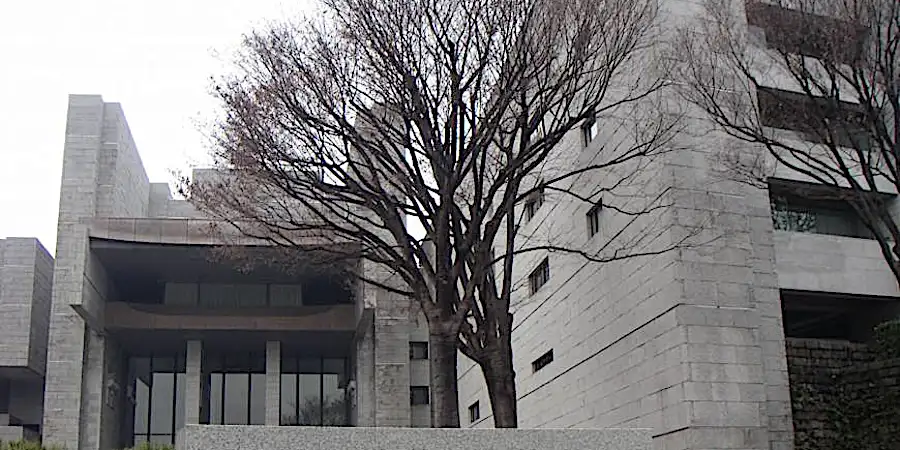SASHIMONO SHI
- MARKETS
- 109.97 ¥/$ (5 p.m.)

OUR LIVES
Master craftsman carries on sashimono tradition
Artisan Yoshio Inoue is one of only 10 Edo Period-style joinery masters with the ability to bring out the best in wood
BY MICHAEL KLEINDL
SPECIAL TO THE JAPAN TIMES
On the floor of an eight-tatami workshop sits master craftsman Yoshio Inoue in a spot he has occupied for decades. His atedai, the long, low slab of wood that serves as a workbench, is in front of him, and within easy reach are scores of tools — chisels, planes, hammers, saws, clamps and other implements of the Edo sashimono.
Born in the old Tokyo town of Asakusa, Inoue learned sashimono — wood joinery — from his father, who learned it from another master in a line of artisans stretching back hundreds of years. Inoue has been building cabinets, chests, boxes, desks, low tables, free-standing screens and other traditional products for more than 50 years. His quick smile, though, and unlined face belie his 71 years.
His workshop is in Uguisudani, a slow-paced neighborhood near Ueno. To his right sits son and successor, Takeshi, 41. To his left sits Motoko Kawauchi, 35, a woman who has been his apprentice for the past 12 years.
Each has their own atedai and array of tools. The rest of the small workspace is crowded with rough lumber of various kinds of wood, sharpening stones and an old electric table saw. A patina of fine wood dust coats almost everything.
On Inoue’s workbench sits what looks like a slim wooden book. A few weeks earlier in cafe gallery Kigaku-an in Yanaka, during an Edo sashimono exhibit featuring the works of several local craftsmen, Inoue was showing some of his own exquisitely beautiful products, including a low chest of drawers and a small booklike object.
“This is an aibiki,” he said of the object, picking it up.
He tilted it gently against the light. The wood across the top and back was rich with skeins of dark brown lines of grain twisting and flowing across a lighter background of yellow-brown wood that shimmered and glistened with lustrous flashes of gold.
“This is mulberry,” said Inoue as he tilted it again. “Look, the gold comes out.”
Mulberry, he explained, was the favorite wood of Edo Period sashimono craftsmen because of that golden iridescence.
Achieving that luster is not easy. As with all sashimono pieces, the wood must be hand-planed multiple times and polished to reveal the best grain pattern. Then eight thin coatings of urushi (lacquer) are painstakingly applied.
“The urushi penetrates the lines of grain, darkening them,” said Inoue, gesturing with his stained thumb. “And it also brings out the luster of the wood.”
That slim object was actually a cleverly designed portable stool easily carried in a bag and used for sitting in seiza, the traditional position of sitting on one’s heels, which, for most people, quickly results in numbing pain in the knees and ankles.
Inoue leans forward and takes the slim aibiki from his workbench. The back consists of two panels snugly attached to the top piece by sliding dovetail joints. Inoue gently pulls the panels off, flips them on their edges and slides them back into the grooves forming two “legs.”
“This is an Edo Period design,” he says. “It will support someone weighing more than 100 kg.”
Inoue’s style is immaculately restrained. Every piece of furniture is made to emphasize the beauty of the wood, especially the grain, and to not call attention to his skills as an artisan.
There are two other major sashimono craft traditions in Japan, but they differ from the Edo variety in several ways. Osaka sashimono artisans have long specialized in using foreign wood, such as red sandalwood, rosewood or ebony. Kyoto sashimono is characterized by a more luxurious appearance that sometimes uses mother-of-pearl inlays or colorful lacquers.
Edo sashimono craftsmen, however, use only wood sourced from within Japan. Their products are made for daily use, simple and stylish, embodying the aesthetic ideal of iki, a cool, chic directness. This is because their traditional customers were samurai, kabuki actors and merchants who wanted to avoid any ostentatiousness.
That centuries-old connection with kabuki actors still continues. Last year, Inoue built a dressing table for 8-year-old actor Ichikawa Danko V, the son of Ichikawa Chusha IX (Teruyuki Kagawa) and grandson of Ichikawa Ennosuke III, the renowned actor famous for his elaborate Super Kabuki productions.
In Edo sashimono, just as in a Bach fugue or a Rembrandt painting, the elaborate technical mastery of the craftwork is concealed.
The most difficult technique is the kakushi ari gumi tsugi, a full blind mitered dovetail joint, in which the joinery is completely hidden to ensure a seamless flow of the grain from the top to the sides.
“It took me two or three years to get those joints right,” recalls Inoue. “The techniques I learned as a young man, I forgot them now,” he says, laughing, “but my body remembers.”
As a demonstration, he nimbly swings his left leg up onto the workbench and secures a board with his heel. He quickly positions a chisel and with a few deft hammer blows cuts out a sample dovetail joint in a matter of seconds.
There are now only 10 officially recognized Edo sashimono craftsmen. All are in their 60s and 70s, and finding successors is one of their main concerns.
Takeshi remembers playing in his grandfather’s workshop.
“The oyakata (master),” says Takeshi, meaning his father, “never pushed me to become a successor.” But his grandfather hoped he would choose that path.
“As a child, I always liked making things,” the younger Inoue explained. He didn’t like studying, but a teacher once praised him for something he made in class. “I still remember that.”
And after graduating from high school, he became his father’s apprentice.
Kawauchi, who is from Yokohama, remembers going to a sashimono exhibit while still in college and seeing Inoue’s work. She was fascinated by his craft and wanted to learn, but didn’t know how to proceed.
“I had this image of standing at the front door of the master everyday in rain or wind, hoping to be accepted as an apprentice,” she recalls. “But I didn’t want to do that.”
Instead, she asked for permission to visit Inoue’s workshop and watch while he made things. She started commuting daily from Yokohama for those visits, and after a few months, Inoue agreed to train her. “She worked really hard,” says Inoue. “There was a lot of blood from cut fingers,” he adds with a smile.
In 2009, Kawauchi entered a government-affiliated craft competition with a uniquely designed six-door cabinet, winning the newcomer prize. She is considering taking the master test and setting up her own workshop in Yokohama.
Wood, of course, is the craft’s most important resource, but it’s also one of its biggest problems. Wood must dry — for six months in the case of a commonly used wood, such as Amur corkwood, but up to 10 years or more for mulberry.
“If an order comes in,” says Takeshi, “we can’t say, ‘Please wait 10 years for the wood to dry.’ “
“We must have stock,” adds Inoue. “You never know when an order will come in, so when a good piece of wood becomes available, you must buy it, hoping you can use it someday.”
His mulberry wood, for example, came from wild trees found on the islands of Miyake or Mikura, in the Izu Island chain south of Tokyo. It’s hard to come by and quite expensive.
“But storing wood for 10 years is not like money in the bank earning interest. It only sits in the warehouse,” says Inoue with a laugh. “That’s why craftsmen never become rich.”
Times are lean for Edo sashimono artists. Tatami rooms, which best suit traditional furniture, are becoming scarcer, and many people can no longer afford the price of a handmade product.
Still, orders come in. “Recently, young people are starting again to become interested in things that last a long time,” says Inoue. Repair work is also increasing.
To attract new customers Inoue will sometimes make a new, nontraditional article. He recently made a wine box from lignitized zelkova that had been buried for centuries. The lignitized wood, he says, takes on a unique hue and personality.
He designed the box in his head, he explains. It holds two wine bottles resting comfortably side by side under a gracefully curved handle. Cut inconspicuously into the bottom edge of the box is a long arching curve like a “curly bracket” laid on its side. That same curve was cut into the bottom edge of a low chest of drawers at the Kigaku-an exhibit.
“Ah, indeed,” says Inoue, “that’s my taste. I almost always use that curved cut in my work.”
When viewed from above, the curve is nearly unnoticeable. Only when you lean down low can you see his lovely comment flowing along the bottom edge, making the line more interesting.
Inoue’s style differs from others by that lightness of line, and by the dimensions of each individual piece.
The personality of the craftsperson, says Inoue, comes out especially in how the corners are done.
“You see it in their thickness or thinness and in how the corners are trimmed or rounded off,” adds Takeshi. Taking off too much, he explains, weakens the appearance, but not taking off enough makes the thing look too strong.
The four corners of the assembled aibiki are gently rounded and the top has been worked so that it thins, sloping ever so slightly toward each edge to make a more comfortable seat. And from the flow of the grain — along the top and across the two back panels — it’s clear that the stool was cut and fashioned from one small piece of mulberry wood.
“Wood is hundreds of years old,” says Inoue. “You don’t want to just cut off pieces and throw them away. We have to treat wood carefully.”
For inquiries or repair work, call Inoue Woodcraft (in Japanese) at (03) 3807-3426 or email inoue-sashimono@nifty.com. Cafe Kigaku-an (7-4-2 Yanaka, Taito-ku, Tokyo, 03-3821-2477, open 11 a.m. to 6 p.m., closed Monday, Tuesday, second Wednesday and third Saturday) has a display of sashimono pieces for sale in the cafe gallery, including Inoue’s work.




 CLICK TO ENLARGE
CLICK TO ENLARGE


![[Gallery] These Airport Security Photos Captured by Other Travelers Will Make You LOL [Gallery] These Airport Security Photos Captured by Other Travelers Will Make You LOL](https://images.outbrainimg.com/transform/v3/eyJpdSI6ImQ3YTI5MDUyZWIzZDUyY2I0NjZiYzY5YWRhMzYwZTA1M2M3MmY4NzljYmYwMzJkNzQ1ZmRiZDAzNDdmMDYwNWQiLCJ3Ijo2MDAsImgiOjMwMCwiZCI6MS41LCJjcyI6MCwiZiI6MH0.webp)

![[Photos] Millions Are Grieving Over Jonathan Scott’s Tragic Loss, And It Will Have You In Tears [Photos] Millions Are Grieving Over Jonathan Scott’s Tragic Loss, And It Will Have You In Tears](https://images.outbrainimg.com/transform/v3/eyJpdSI6IjBjNjM1NjZlOTE2YjNjZDIxNmIyZTNjZDRlZTYyZGQ4ZGNiMmM5ZjNjZTk3N2ViYzEwNmY0MmQxNjI5ZDJkMWQiLCJ3Ijo2MDAsImgiOjMwMCwiZCI6MS41LCJjcyI6MCwiZiI6MH0.webp)





Comments
Post a Comment